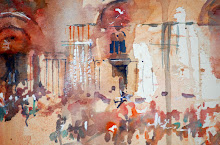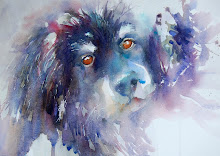African Himba Girl Inspired by a Photograph by Tom Ang.
http://www.tomang.com/
This morning I have been in contact with several artists where the subject of copying arose and I have been asked for advise. It is an area which creates so much confusion but for me whether a piece of work is original or not is simply black or white. Either you create an original painting. Or you copy and the result is not your own composition or idea.
Is copying wrong?
It can be seen as a recognised method of learning as from art books or from tutors giving instruction. However a line is crossed when copying occurs with the intention to sell or gain profit from another artists expertise.
.For years artists have studied masters they admire. The artist with the camera creates as the one who holds a brush. Both aim to capture subjects in their chosen field. But what happens when you see an image online that completely turns you on and that yearning inside begs you to paint it?
.For years artists have studied masters they admire. The artist with the camera creates as the one who holds a brush. Both aim to capture subjects in their chosen field. But what happens when you see an image online that completely turns you on and that yearning inside begs you to paint it?
This happened to me recently with a wonderful photograph of Himba Girls taken by successful, professional photographer and well known author Tom Ang. I had met Tom a few years ago and he was one of the first people I told about my dream to write a book. He was so inspirational that it was wonderful to let him know recently I have taken the leap and started writing.
But even if I hadn't known Tom I would have acted in exactly the same way. I contacted the original artist of the photograph I had fallen in love with and explained how inspired I was by the scene. I explained I would love to paint it to explore the figures which Tom had caught in a brilliant composition. It was Toms vision that had attracted me. His way with a camera.
Tom had been there, seen the girls and with his amazing skill caught a moment in time. The expressions on the girls faces called to me.The way the sunlight played creating shadows excited me. My artists soul was turned on by the colour and story. I could see easily a collection of studies turning into one large painting. I became totally turned on by the prospect of painting this scene and almost obssessed with it.
There was one drawback.
The original photograph wasn't mine.
I had to contact Tom. When I recieved his permission to paint this scene I then studied the image even more closely. I thought about the man behind the camera and what he had caught in this image. The story began to emerge of the figures with the feeling of actually seeing them moving and interacting. I began to feel the suns rays on their skin and started thinking about these young women and their lives. All of a sudden this image became more emotional to me as I compared their daily routine to mine.
Without knowing what was happening the connection between Toms vision and my white piece of paper started to feel real. A unison of artistic souls.
I know that when I finally paint the scene it is highly unlikely anyone looking at my piece may even recognise the similarities to Toms original photograph. In fact it may bear no resemblance at all to my watercolour exploration. But that really is not the point. And I am sure this is where problems arise regarding copyright law.
I often hear students saying they changed the colour of a hat or cropped the composition or added a few more details. It doesn't matter how much you change your painting from what you are copying. The botttom line is you are using the original artists inspiration to create.
Tom may never have seen this painting but if he had and he recognised it a legal battle could have followed. Many artists assume that will not happen. It can and does even though many of us turn a blind eye.
I have been copied in the past and I am sure will be copied in the future. I give permission when approached for my subjects to be used for learning purposes. Because we do all wish to learn and improve. I would also make a terrible teacher if I didn't allow anyone to follow my demonstrations!
But copying with the intention to sell is another matter. One that falls on the honesty of the one behind the copying and sadly not everyone is honest about how they created their paintings. A copy of one of my rose demonstrations is on sale as a card on a popular web site. The copying artist merrily describing how they painted the creation as if the process was entirely their own. More recently an exact copy of one of my paintings appeared on Ebay but the artist had the kindness to add " Inspired by Jean Haines" after the title.
I have learned a lot from so many artists about approaching copying artists and my advise to anyone considering doing so is to leave well alone which isn't really good advise! It is unpleasant and no artist really wants to be faced with this dilemna. Apart from that anyone who copies knows exactly what they are doing . Strangely more often than not the original artist always ends up feeling as though they are the guilty party for bringing the matter up in the first place!
But here I am and I cannot get to Africa and I am in love with Toms Himba Girl photograph.
I have my self respect and honesty which I hold very dear. I have taken the right route and contacted the original artist.
So with my study which is hopefully the beginning of a larger piece I not only have Toms permission but also his approval to share this painting on my blog. At each stage the original artist will know what my plans are for this watercolour journey.
In this case I also know the original artist likes this study. Furthermore his views on how I have portrayed his photograph have helped me so much as an artist in that I am now looking at this small study through Toms eyes. How wonderful is that? As a master Tom sees things so very differently to me so his help has been invaluable.
I can go to where he took this beautiful image from his insight and define what I wish to portray in my next watercolour of this girl.
I am not ceratin at the moment where I will be heading with this exploration into a composition of figures and I may end up with a painting I wish to frame. And here is where I would contact Tom again . Why ? Because professionally I know this will not be my painting to sell. I am merely inspired by Toms wonderful photography.
So apart from giving credit to the original photographer I then have the decision to be made with his help on the future of any successful paintings from his inspiration.
The word "original" can only be used if you are painting something completely from your own source.
Here I would like to thank Tom for his permission and his feedback. I really appreciate how busy we all are as artists so to share is a sheer joy especially with someone as incredible as Tom.
To close it might be worth noting that even if you don't admit publically you have copied an original painting or photograph be warned! There are often many others who will recognise a copy of the original painting or photograph. Asking permission and then adding the inspirational name when permission is gained will aid your reputation.
Being seen as someone who copies and dishonestly so does not!
*********************************
Full information regarding Tom Ang and his wonderful work can be found on this link.
http://www.tomang.com/
***********************************

























4 comments:
This subject has been on my mind lately. I don't copy, I take my own photos for reference and that's all I use to create paintings. But like you if I was so moved to paint a particular photo I would contact the artist first. It would feel like cheating myself, and it would eat at me forever if I tried to pass it off as my original creation. When I was first learning to paint I did copy other artists works, but I never sold them or acted like it was my original idea. But this is such a tricky subject, so thanks for all you said, I agree with you completely :)
Hello Crystal,
Thank you so much for your reply to such a lengthy blog entry. I loved your comment on feeling as though it could be cheating to use another artists idea and I totally agree with you.
It is a sticky subject because tempers can quickly flare on both sides.
Those who copy can always come up with a reason why they are not "technically" copying whilst artists who are copied feel upset their work has been used unethically.
In all honesty I feel rather brave even touching the subject because this subject will always be ground for huge disagreements.
Jean
I think you should feel rather brave of yourself :) This is quite a sticky subject, but you handled it beautifully.
Thanks for tackling this subject. As an art teacher I have had students "copy" famous artists to get the feel for say an impressionist style. And of coarse the purpose is not for claiming an original or to sell. These guidelines are good to know, and to pass on to my student.
Post a Comment